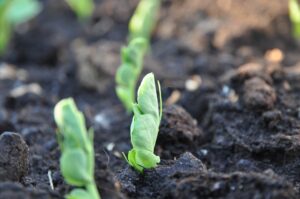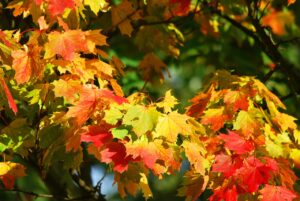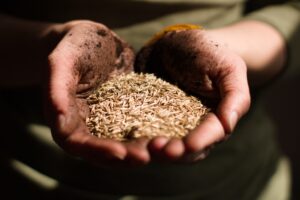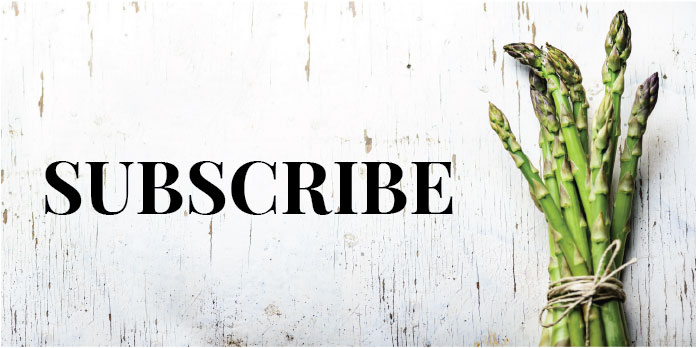Welcome to our first blog.
When we started to think about a topic to write for our very first blog we began brainstorming about what we wish we had known when we started our journey.
A long list of ideas were drawn (some will feature in upcoming blogs) and discussed – in length. Finally, alongside ‘patience’ and ‘water’, we resoundingly came up with soil health and ultimately Compost – which we lovingly refer to as ‘nature’s gold’.
Never did we imagine that compost would play such an ever increasing role in our daily living. Nor did we realise the positive financial, environmental and health benefits associated.
What exactly is compost?
Composting for many people means different things, but quite simply, compost is organic matter (compared to inorganic) or organic by-products that have been collected together and given time to break down with the aid of beneficial bacteria, fungi and worms into a nutrient rich fertiliser or soil additive.
What can and cannot be composted?
Almost anything that is grown or comes from a natural source can be composted. As our composting journey continues to evolve we always find new things that can be composted.
Composting is often split into two distinct categories, green (nitrogen rich) and brown (carbon rich). It is essential that you have a good mixture of green and brown components in your compost pile. With too much green matter, the compost pile will begin to smell and attract vermin, and too little green matter, the breakdown process will be very slow indeed. A good recommendation is around 70% green to 30% brown where possible. *Remember too, if you are regularly adding nutrients to your compost, it can be a great idea to occasionally check the PH levels. Follow this link for Gardening Australia’s information on how to simply check!
Examples of green items that can be composted.
- Vegetable scraps
- Fresh lawn clippings – we try to avoid grass that is too seedy
- Weeds – try to avoid weeds that have gone to seed or remove and discard the seed components.
- Hedge trimmings
- Green leaves
Examples of brown items that can be composted.
- Paper or cardboard – ensure plastic labels, tape and staples have been removed.
- Straw
- Autumn leaves
- Dried grass clippings.
- Untreated sawdust or wood shavings
Other items that can be composted.
- Pet or human hair/fur
- Herbivore manure, i.e goat, horse, sheep or cow
- Chicken manure
- Egg shells
- Nut shells
- Paper scraps
- Coffee grounds
Items that should not be included in a home compost include:
- Dog/cat or human faeces. While we acknowledge that this is done by the more adventurous gardener we recommend that it be avoided due to the bacteria and pathogens associated.
- Dairy products – cheese, milk, yoghurt, etc
- Meat
- Oil or fats
- Weeds that have gone to seed
Good for the environment and your pocket.
Once upon a time, spending in excess of $200 a year to discard our green waste felt like a bargain, fast forward a number of years and the thought of spending any money to discard our garden waste feels criminal. While not only saving money on tip fees, composting has been one of the ways we have considerably reduced the need for purchased fertilisers for our gardens; a good healthy compost is packed full of beneficial nutrient organisms and bacteria.
While saving money by composting, you are also actively helping the environment.
When organic materials are sent to landfills they do breakdown, but more often than not they break down without oxygen. This breaking down of material without oxygen produces greenhouse gasses (most commonly methane gas) that slowly leache out of the landfill and contribute significantly to climate change. You may be surprised as we were to know that Methane gas has a 25 times greater impact on climate change than carbon dioxide (Car Fumes, Fires etc). We can’t think of a better reason not to start composting.
No Space or time for composting.
We appreciate that not everyone has access to an outdoor space to compost or they simply do not have the time but there are still things that you can do to help reduce your waste.
Ask a neighbor, relative or work colleague. Many compost enthusiasts are all too willing to take your vegetable scraps or even small garden waste off your hands to top up their bins. We are also aware of networks of composters on social media that offer drop off points. Put it out there, remember there is no harm in simply asking a question and you may be surprised who is happy to take your waste.
Contact your local council. Many local councils are cottoning on to the importance of composting and reducing waste entering landfills. Your local council may be able to provide you with a regularly collected bin for household compostable waste or garden green waste. They also may be able to supply you with contact details for independent contractors or companies who supply this service.
Two of the most common types of composting are listed below and will no doubt fit your family.
Bay
Bay composting is the perfect solution for those who have a good size backyard and produce a medium to high amount of garden waste such as lawn clippings, leaves, and trimmed or pruned material. We have a two bay system whereby one bay is constantly being added to whilst the other is resting and breaking down. In hindsight we would have installed a 3 bay system that would give smaller amounts but a more frequent supply of compost.
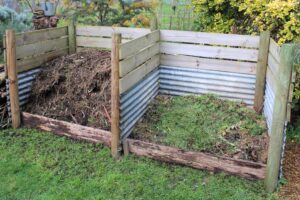 ‘Lasagne or Sheet’ technique: Just like you would construct a lasagne by adding layers of pasta and other ingredients you can construct your compost pile in this fashion, start with a layer of cardboard or paper, add some larger sticks or branches, then a layer of leaves, some smaller sticks and them some grass clippings. Repeat if you have the right amount of material. While you may not always have the amount of material available or the correct type of material for the next layer if you keep loosely to format, you will have a much healthier compost pile and see quicker results. Layering in this way also ensures oxygen remains in the pile, as your pile begins to break down you may need to aerate using a pitch fork, metal rod or as we have been known for – a sturdy plant stake!
‘Lasagne or Sheet’ technique: Just like you would construct a lasagne by adding layers of pasta and other ingredients you can construct your compost pile in this fashion, start with a layer of cardboard or paper, add some larger sticks or branches, then a layer of leaves, some smaller sticks and them some grass clippings. Repeat if you have the right amount of material. While you may not always have the amount of material available or the correct type of material for the next layer if you keep loosely to format, you will have a much healthier compost pile and see quicker results. Layering in this way also ensures oxygen remains in the pile, as your pile begins to break down you may need to aerate using a pitch fork, metal rod or as we have been known for – a sturdy plant stake!
Where possible, we try to time our yearly tree pruning by starting to fill our new bay first. This way our larger branches and twigs will be on the bottom and will enjoy the maximum decomposing time.
Bay composting is not recommended for the composting of fallen fruit or kitchen scraps, due to the open nature of the bins, they provide the perfect environment for mice, rats and possums who are after a warm home and an easy meal.
In our hot Victorian summers we find that a good watering once a week of our compost bays ensures they are kept adequately moist and healthy. Depending on your climate you may need to increase or decrease the frequency.
Compost Bins
Without doubt the most popular and widely used ways to compost are black compost bins. Whether you have a small backyard or large farm every household would benefit from having one or two of these (we have 5). They are readily available from hardware stores, nurseries and online. Compost bins are the perfect solution for all your kitchen scraps, paper and basic garden waste. Much like composting bays, the correct amount of green and brown waste is vital for a healthy bin.
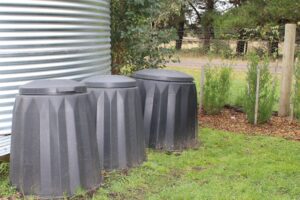
Your compost bin should be situated on a porous surface and should receive a good amount of sun and shade – too much sun will result in the bin drying out and all the “good stuff” in your compost bin dying.
Keeping your bin moist is essential but just as importantly keeping well oxygenated is critical, not only will this dramatically improve the rate of breakdown of the material inside but by regularly turning the bin contents with a spade or compost aerator you will be disturbing the potential nesting sites of any rodents that might like to set up home.
When can I use my compost?
As we mentioned at the start of this article, one thing we have learned when gardening is patience is a must. Rates of composting will vary depending on your climate, size of your compost bin or bay, size of material used and how often you tend to it. As a guide, once full and no further material is added (unless required) you should expect to be adding “natures gold” to your garden in approximately a good four seasons (a year).
A common misconception is that compost needs to be fine like soil before it can be used but we have found not only is it extremely time consuming and hard to achieve, but many nutrients have leached by this stage. A compost that is well rotted but has texture is perfect and will assist in good drainage and water retention in your garden.
Why not give your own ‘natures gold’ a go!

